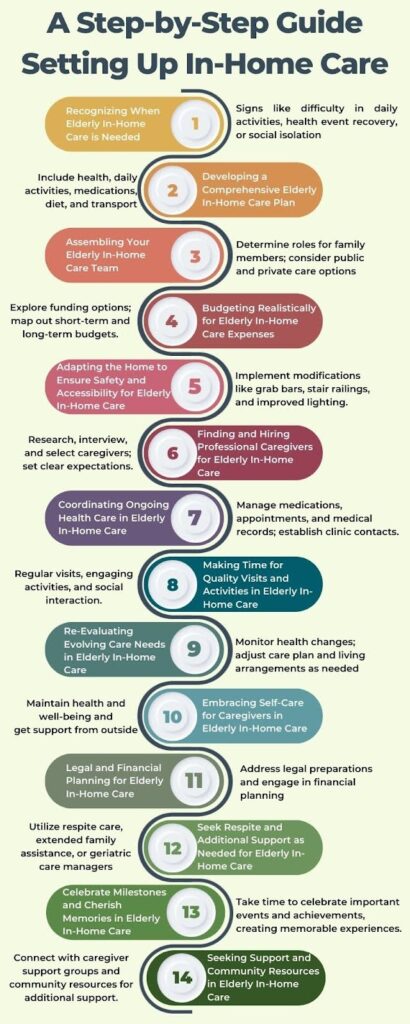Caring for elderly loved ones is a deeply emotional journey. It’s filled with love, concern, and a strong desire for their comfort and dignity. This task requires emotional commitment, careful planning, and coordination. In Canada, more seniors are choosing in-home care. This choice allows them to age gracefully at home. In this article, you will learn:
- How to wisely choose the right time for in-home care for older adults.
- How to create a detailed care plan for your loved one.
- How to ensure continuous support and adapt to changing care needs.
In the next sections, we will guide you through a step-by-step process. This will help you set up in-home care for your elderly loved one.

Step 1: Recognizing When Elderly In-Home Care is Needed
Knowing when to start in-home care for the elderly is delicate. It’s like understanding complex poetry. You need a keen eye, a sensitive heart, and a strong commitment. Look for clear physical signs. These include trouble moving around, sudden weight changes, injuries, or poor personal hygiene. Mental and emotional signs are also important. These include forgetting medicine, losing interest in activities, or mood changes. The home’s condition is telling too. Look for undone chores, unpaid bills, or accidents. These signs show safety risks or trouble with daily tasks. Paying attention to these signs is crucial. It’s the first step towards the supportive care that in-home services offer.
Step 2: Developing a Comprehensive Elderly In-Home Care Plan
A well-thought-out care plan is key in setting up elderly in-home care. It’s a mix of health needs, daily routines, medication management, therapy, meals, and transportation. Working together is important. Get input from your loved one, family members, and healthcare providers. A good care plan is more than a document. It’s a dynamic guide to compassionate, tailored care for the elderly.
Step 3: Assembling Your Elderly In-Home Care Team
Establishing a care team for elderly in-home care is crucial. Work with family members to find out how each can help. Roles can vary from grocery shopping to doctor’s visits and household management. Explore options such as public home health agencies or hiring a private geriatric care manager and home health aides. The correct team can significantly enhance the care experience.
Step 4: Budgeting Realistically for Elderly In-Home Care Expenses
Budget planning for elderly in-home care is crucial. Determine what public health care covers and assess whether private services are necessary. Look into financial support options like health insurance, government programs, or personal savings. Proactively managing and being clear about finances helps set expectations and plan for sustainable care.
Step 5: Adapting the Home to Ensure Safety and Accessibility for Elderly In-Home Care
Ensuring the home is safe and accessible is vital for elderly in-home care. Small changes can greatly improve safety and movement. Consider adding aids to assist and making changes to reduce risks. This contributes to creating a secure and comfortable space for older adults.
Step 6: Finding and Hiring Professional Caregivers for Elderly In-Home Care
Professional caregivers are key in elderly in-home care. Interview them carefully, check references, and make sure they match your loved one’s needs. Good communication and regular check-ins are important for a smooth relationship between the caregiver, the elderly person, and the family.
Step 7: Coordinating Ongoing Health Care in Elderly In-Home Care
Managing healthcare services is crucial in elderly in-home care. Keep accurate records, manage medications and appointments, and communicate with healthcare providers. This proactive approach helps avoid complications and ensures top-notch care.
Step 8: Making Time for Quality Visits and Activities in Elderly In-Home Care
Beyond care tasks, spending quality time with elderly loved ones is important. Regular, meaningful interactions enhance their quality of life. Make time for activities they enjoy to create lasting memories.
Step 9: Re-Evaluating Evolving Care Needs in Elderly In-Home Care
Regularly assess the changing needs of your elderly loved one. Be alert for subtle changes and ready to adjust the care plan. Open communication, flexibility, and compassion are key during these changes.
Step 10: Embracing Self-Care for Caregivers in Elderly In-Home Care
Caregivers must also take care of themselves. The demands of caregiving can be heavy. Allow yourself breaks, relaxation, and seek support from groups, counseling, or respite services. This helps you stay strong and compassionate in your role.
Step 11: Legal and Financial Planning for Elderly In-Home Care
Legal and financial planning is a key part of elderly in-home care. Prepare legal documents like power of attorney and wills. Plan finances for sustainable care. Look into insurance, financial power of attorney, and estate planning.
Step 12: Seek Respite and Additional Support as Needed for Elderly In-Home Care
Don’t hesitate to seek extra help when needed. Respite care, family help, or geriatric care managers can provide needed breaks and ensure continuous care.
Step 13: Celebrate Milestones and Cherish Memories in Elderly In-Home Care
Take time to celebrate special moments with your elderly loved one. Birthdays, anniversaries, and personal achievements create joyful memories in the caregiving journey.
Step 14: Seeking Support and Community Resources in Elderly In-Home Care
Connect with caregiver support groups and community resources. Sharing experiences with others provides strength and inspiration in your caregiving role.
Conclusion
Caring for an elderly loved one at home is a journey of love and dedication. This guide helps navigate the complexities of caregiving. From recognizing needs to legal preparations, self-care, and celebrating milestones, each step contributes to quality care. May you find strength, support, and fulfillment in this caregiving journey. Remember, it’s a continuous process, a lasting tribute to your loved one.
Frequently Asked Questions
In-home care refers to the provision of various support services for elderly individuals within the comfort of their own homes. It includes personal care, medical assistance, companionship, and more to help seniors maintain their independence and well-being.
You should consider in-home care when you notice signs of physical decline, mental health issues, safety concerns, or difficulty with daily living activities for your elderly loved one. Recognizing these signs is crucial for providing timely support.
A comprehensive care plan is a personalized roadmap for your loved one’s care. It includes details on medical needs, daily routines, medication management, and any specialized care services needed. It is created with input from healthcare professionals and family members.
Financing in-home care may involve a combination of public health programs, private insurance, government programs, and personal savings. Explore long-term care insurance and financial planning to determine the most suitable financial approach.
Respite care provides temporary relief for caregivers, allowing them to take a break from their caregiving responsibilities. It is essential for preventing caregiver burnout and ensuring the well-being of both the caregiver and the elderly individual receiving care.


